“Vonda McIntyre writes science fiction.” So sings the author’s pithy bio at the magazine Strange Horizons. Yet the contributions of the science fiction and fantasy icon and founder of Clarion West throughout her career speak volumes, and encompass so much more than you might realize.
It was two years ago this month that Tor.com reported on McIntyre’s passing. To mark the recent anniversary, I’ve put together a helpful guide to McIntyre’s life and work—and of course, how and where to read and enjoy her remarkable fiction.
To longtime science fiction fans, Vonda McIntyre is a household name—but some newcomers may need a refresher course. McIntyre was a teacher, author, former biologist, and crotcheter of (what I imagine to be adorable amigurumi) marine creatures. And, of course, she was the author of a number of science fiction novels and short stories.
Originally from Louisville, KY, McIntyre moved to Seattle with her family in the 1960s, at a time when the city seemed to be looking more to the future than the past—it was 1962 when the Space Needle first rose into the heavens for the World’s Fair. The Emerald City has long counted a number of notable science fiction writers among its many denizens, from Octavia Butler to Cat Rambo and Nancy Kress. But McIntyre was one of the first.
McIntyre contributed to the field of science fiction beyond her published writing. As a teacher, she helped found the Seattle-based edition of the Clarion workshop, which had been previously held in Clarion, Pennsylvania. Today, Clarion West hosts a wide array of speculative fiction classes and workshops taught by talents such as Nisi Shawl and Meg Elison, helping emerging writers to develop their craft, voice, and confidence, and make connections.
McIntyre was also a collaborator and co-conspirator of Ursula K. Le Guin, who once called McIntyre’s Starfarer series “the most important science fiction series of all time.” During her career she won three Nebulas, and was the third woman to win the Hugo Award for Best Novel. She was nominated for an impressive number of other awards and accolades and was a Guest of Honor at Worldcon in 2015. According to her obituary, she continued writing until the end, when she died of pancreatic cancer in her Seattle home.
Where to Start with McIntyre’s Series and Standalone Novels
Though fans of Star Trek and Star Wars may know her best from the novels and novelizations she set in those universes, McIntyre is also celebrated for her science fiction series and several acclaimed standalone novels.
The Starfarers Quartet
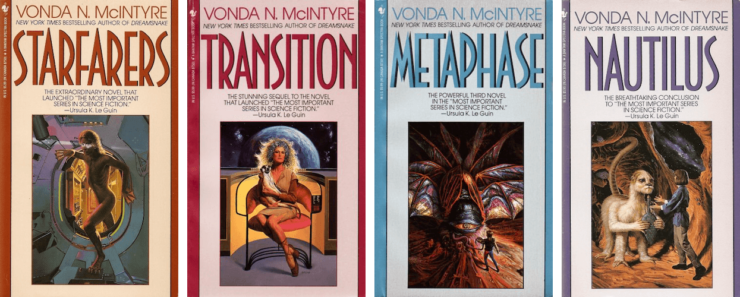
An American research ship sets out on its maiden voyage, and is never heard from again. The series features a diverse cast, especially for its 1989 debut date, and a series of interstellar hijinks, the likes of which only McIntyre could conjure. Although, as McIntyre told the story, she dreamed up the entire Starfarers series while listening to grievances about bad science fiction TV as she sat on a panel at a convention. She convinced the audience that the show already existed, and that they had all somehow missed out on the Best SF TV Series Never Made! Luckily for us, she followed through on the books and now we have another wonderful science fiction series to read.
The Starfarers Quartet includes four books: Starfarers, Transition, Metaphase, and Nautilus. The whole series can be found in the Starfarers omnibus or as individual, collectible novels.
Dreamsnake
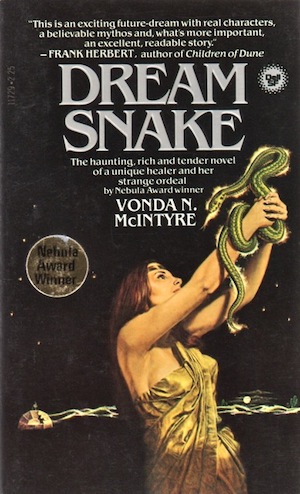
Published in 1978, Dreamsnake won both the Nebula and the Hugo Award. The novel was an expansion of her award-winning novelette “Of Mist, and Grass, and Sand.” The main story follows a healer who uses an alien serpent to comfort dying people in the aftermath of a nuclear holocaust on Earth.
The Moon and the Sun
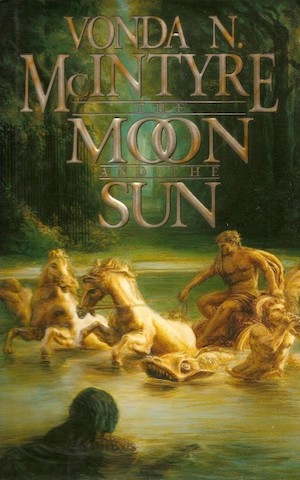
Almost twenty years after Dreamsnake, McIntyre won the Nebula again with her novel The Moon and the Sun. The book, which beat out Game of Thrones for the Best Novel Nebula in 1997, concerns an alternative history of the 17th-century French court of Louis XIV. Like Dreamsnake, The Moon and the Sun was an expansion of one of McIntyre’s short stories, “The Natural History and Extinction of the People of the Sea.” Fun fact: the short story, which was written as an encyclopedia entry, was illustrated by the venerated Ursula K. Le Guin.
Superluminal
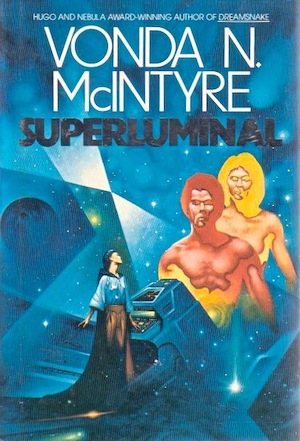
This novel was the first I’d ever read of McIntyre’s, and as a survivor of open heart surgery at an early age, I was hooked, as it explores the ramifications of modifying our human anatomy in order to explore the far reaches of the universe. The sensory details of a society far different from our own are well worth the short read in this standalone. Originally published in 1983, this novel, like so much of McIntyre’s work, was ahead of its time.
Bonus option: “Screwtop” (a double-feature with James Tiptree Jr.’s “The Girl Who Was Plugged In”)
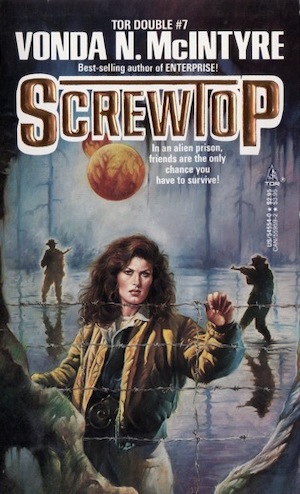
In 1989, Tor Books packaged McIntyre’s 1976 novella “Screwtop” alongside Tiptree’s 1974 double Nebula and Hugo award-winning novella, “The Girl Who Was Plugged In.” In addition to giving readers two excellent stories in one book, these vintage omnibus editions make unique additions to any bookworm’s collection—the two novellas are printed upside down and backwards from one another with separate covers on the front and back, so that you get two complete books in one! (“Screwtop” can also be found in The Crystal Ship, edited by Robert Silverberg, and in McIntyre’s 1979 short fiction collection Fireflood and Other Stories.)
The Case of the Missing Movie Adaptation: The Moon and the Sun (aka: The King’s Daughter)
McIntyre’s only work to become a full-length feature film, she saw her fantasy novel The Moon and the Sun adapted into The King’s Daughter before her death, originally due to be released in 2015. The film, starring Pierce Brosnan, Kaya Scodelario, Fan Bingbing, and William Hurt was produced with a rumored budget of $40 million, with some location shooting even taking place in Versailles. The film follows King Louis XIV’s quest for immortality, and the central plot centers on an illegitimate child who challenges his plan to exploit a captured mermaid.
Unfortunately, the movie has still not been released and remains stuck in limbo, in spite of the fact that filming was completed and a trailer produced, promising that the film was “coming soon.” The full story behind the troubled film has been chronicled here by writer Mark Harrison; here’s hoping McIntyre’s fans might one day have a chance to see it for themselves.
Contributions to the Star Wars and Star Trek Universes
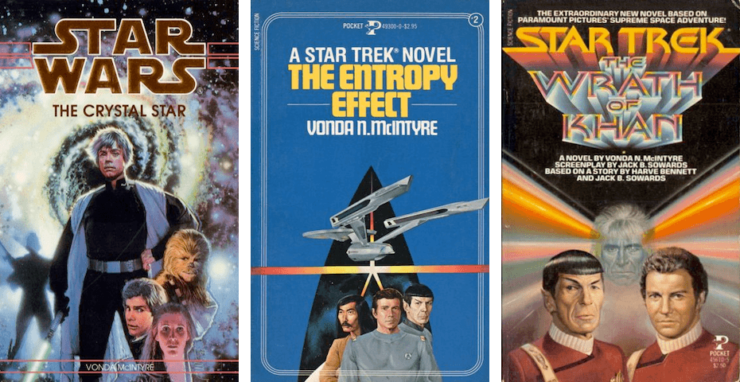
McIntyre only wrote one Star Wars novel, The Crystal Star, set ten years after the battle of Endor and featuring Princess Leia’s children, as well as Luke, Han, Chewie, and R2-D2. The story follows Leia as she tracks kidnappers and the children they’ve stolen while being cut off from Han and Luke by a dying star that’s disrupting the Force.
McIntyre was responsible for many beloved novelizations and standalone Star Trek adventures. These include the novels The Entropy Effect and Enterprise: The First Adventure, and the novelizations for Star Trek II: The Wrath of Khan, Star Trek III: The Search for Spock, and Star Trek IV: The Voyage Home. And of course, she’s responsible for giving Sulu his first name, Hikaru, which became canon after the publication of The Entropy Effect.
Short Fiction
In spite of her impressive bibliography, the Internet is sadly lacking in the way of McIntyre’s stories available to read for free, but here are two that you can read right now:
- Little Faces (Strange Horizons, 2014)
- Misprint (Nature, 2008)
And of course, you can check out the aforementioned short fiction collection Fireflood and Other Stories for more, or check out McIntyre’s full sfadb bibliography if you’re interested in tracking down titles for further reading!
***
It’s been two years since the world lost the giant that was Vonda N. McIntyre. In her delightful biographical sketch of the writer delivered at Lunacon in 1994, writer Eileen Gunn gave us an affectionate, if jokey, window into McIntyre’s life, which gives us some sense of the amazing person we lost. She clearly left a huge and lasting impression on her friends, her fans, and the field of science fiction, and I hope this brief overview of her career inspires you to explore or revisit her work—to the final frontier and beyond.
Meredith Smith has written fiction, poetry, and more for lit mags, riot grrl rags, crypto podcasts, and hipster blogs. She slings her words from the Pacific Northwest, where the coffee is black as midnight on a moonless night. Get in touch at @MTSmithWrites on Twitter.










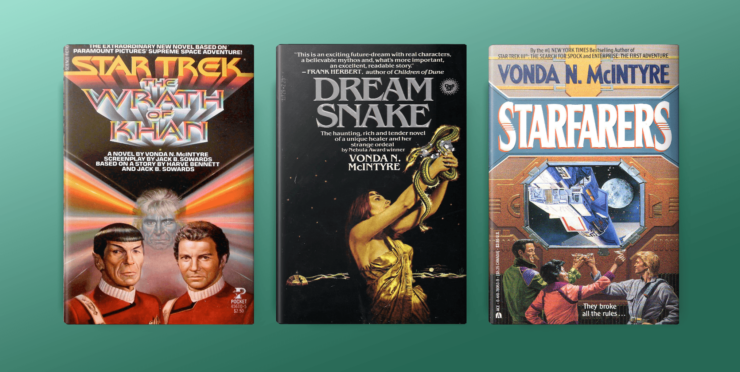
I’m kind of impressed how much that trailer for the Moon and the Sun movie seems to have missed all the things I liked about the book. One of the best parts was how the court was deeply weird and scary despite the luxurious veneer, it isn’t a fairy tale! And it just gives away a major plot point in the title?? Also it’s annoying they went with a conventionally handsome love interest. I’m not sure I want to see that movie at all.
But glad to know McIntyre has a whole back catalog I can peruse, since Moon & Sun is the only book I’ve read.
About Sulu–it’s Hikaru.
@2: Typo fixed, thanks!
I am very fond of her 1979 Fireflood and Other Stories, in particular the two pieces about an alien race and their generation ship. I wish she’d expanded on those.
I, being old, remember Ms. McIntyre’s debut as an author. I have some of her earlier work still in their original paperback…and I would LOVE to see this movie, preferably online as I no longer (even before Covid) attend theaters. The sound system is simply too loud to be endured. Is there a way to pressure a.k.a. “promote” release — and perhaps resumption of its correct name, through streaming. Perhaps Sundance? Thank you for this retrospective of her career and importance, and for telling of the movie I did not know existed.
“King’s Daughter” costumes are terrible. Looks like no attempt was made to have any resemblance to 17th century dress.
I read Dreamsnake for the first time since last century a couple of years ago. While the setting and plot feel quite of their time, the themes are still relevant and the writing is still wonderful. It deserves a much wider audience than it has had for a long time.
This was either by design* or is synchronicity of the highest order …
Dreamsnake is the subject of today’s Featured Article on Wikipedia.
*(I wouldn’t be surprised if one of the people on Wikipedia’s staff who decides what gets featured is a visitor to this site.)
Her first novel was “The Exile Waiting”, which appears to be in the same universe as “Dreamsnake”.
I read it recently; it is very good but not perhaps quite as special as Dreamsnake.
One of her other contributions was co-founding the “Book View Cafe” co-operative.
She was great fun, and I remember exchanging messages with her about which actors you would choose for a hypothetical film of Dreamsnake.
I can’t believe The Moon and the Sun is out of print. It’s such a classic. I have to say I’m glad the movie is kind of dead. They took out all the interesting parts, and the best character!
I love her work so much. Read Wrath of Khan, then found out about her original fiction from a Feminist Theory class a few years later (the professor’s specialty was the intersection of feminist theory, science and sci-fi literature). Ate up Dreamsnake and Superluminal. Terrific characters and prose style. But there was a point where it was impossible to find her earlier work. So glad folks are getting to discover her work still.
@MarkVolund
That’s interesting! Vonda must be in the air!
It’s the anniversary-month of her death from a few years ago, so it may just be that she is on some minds. Thanks for commenting, I’ll check that out!
@Kate – I had such a hard time finding anything on The Moon and the Sun. It’s one of my Holy Grail books. Hopefully this gets it in front of some fresh eyes!
Thanks for all the comments, everyone! Happy reading!
Thank you Tor and Meredith Smith! One of the things I love about books is how they can still be enjoyable and relevant after their author has left us. McIntyre is definitely one of those authors who shouldn’t be missed by newer readers! Might be a good article to share some lesser known true classics!
seems to be a misprint in the link to misprint.
@15 – Fixed, thank you!
@9 I also was introduced to Ms. McIntyre via The Exile Waiting, and that one remains a “comfort read” for me. Of course, I also loved all her other books.
I read Dreamsnake for the first time in 2019 and was surprised it isn’t an HBO or Netflix miniseries. It could be great.
Link to
Misprint
Vonda N. McIntyre
https://www.nature.com/articles/454252a
Pretty good story.
I like the subplot she had in the Star Trek movie novelizations that told of the relationship between Saavik and David Marcus. The reason she was so devastated at David’s death in STIII was because she was pregnant with his child. This made more sense to me than the fan theory that she was Spock’s sex doll when he went through Pon Far on the Genesis Planet.
There was also the scene in the STII:TWOK novelization when Saavik goes to pay her respects to Spock, her mentor, and Peter Preston, her student , in the Enterprise morgue. She allowed her emotions to show when she started sobbing because she lost two people who were important to her. It showed that she wasn’t going to be just another emotional Vulcan. Please note the in the novelizations it was stated that she is half Romulan (she doesn’t know which parent was which).